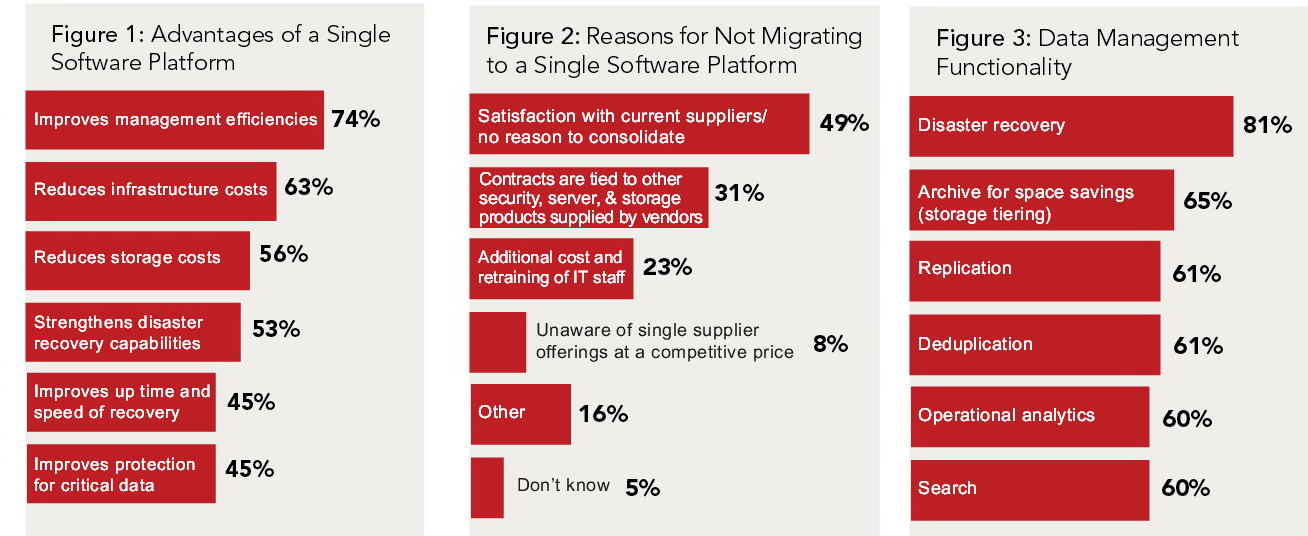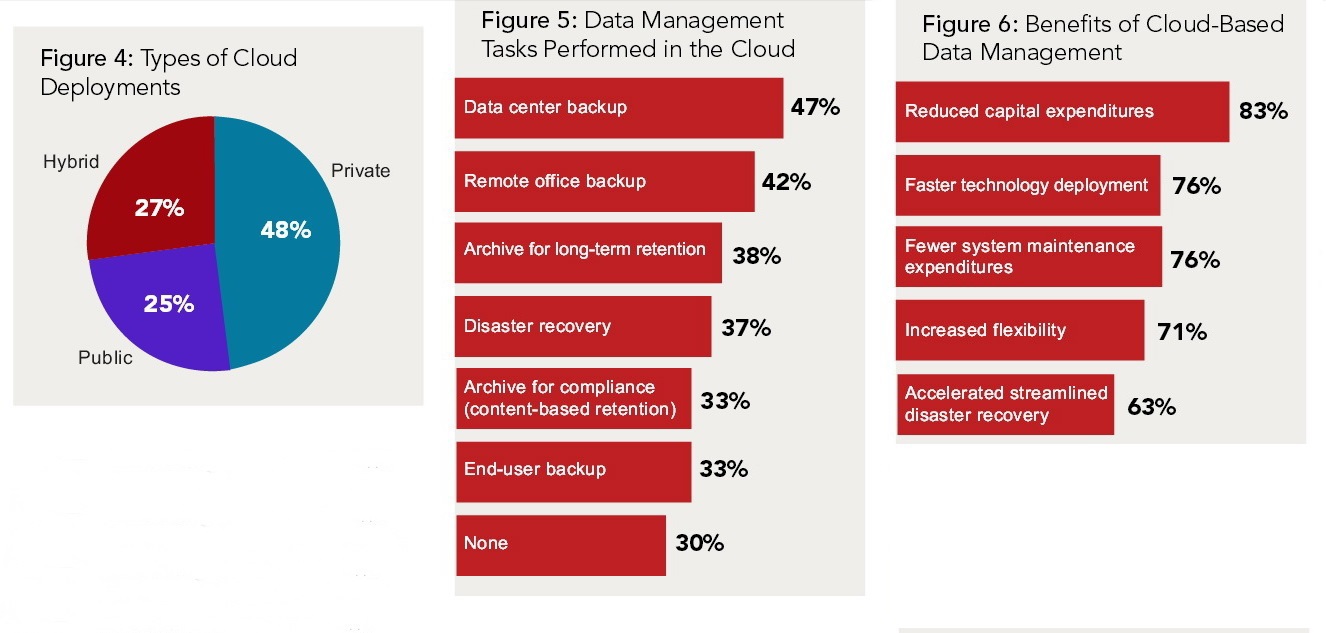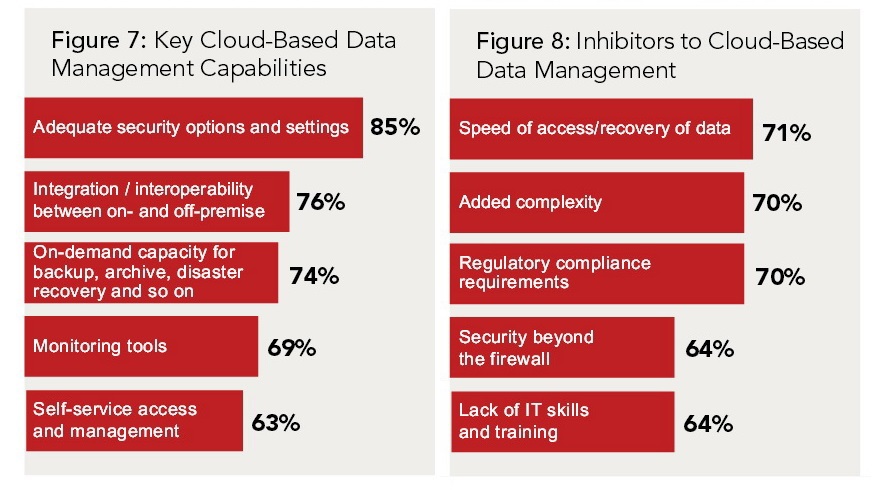Clouds through the eyes of IT professionals: vision and expectations
Information for most organizations of our century has become an extremely important element. Like blood circulating in the body, information delivered at the right time and place plays a crucial role in the functioning and development of a business. The avalanche-like growth of its flows, which the IT companies are now facing, and not only them, required a search for new ways of working with data, its storage and management. The answer to the question “what's next?” Hung in the air did not take long to wait. The growth of Internet channels and their universal accessibility gave rise to this answer - “Cloud services”.

The incoming clouds gave truly limitless data management capabilities. Public, private, hybrid (a mixture of the first two) are all models for controlling access to information, which is not located on the old terabit “Seagate” in the back room of the network administrator, but in the ultra-modern data centers TIER III-IV with an established automatic backup Round-the-clock availability of data from any bearish corner where the Internet is present. At the same time, cloud services may not be too effective for companies that, say, use various software products for production needs, which are not very consistent with each other. The solution to the difficulties can serve as a complete transition of the company's office work to a single software platform, from a single supplier. This is the way of optimization that many companies have gone now, this is a trend. Within one software environment, it is often very easy to organize backup, archiving and recovery of data.
')
A recent study by QuinStreet Enterprise Research (QSER) showed that 35% of respondents in their work faced with the use of one to three software systems, 56% use four or more. The study also showed an obvious, but no less interesting feature: two thirds of the respondents were in favor of moving from the set of software that they now face at work into a single software environment for data management.

The QSER research company is a part of the media holding, which also includes such online publications as EWeek, Datamation, CIO Insight. The survey conducted by the company, including employees from 223 large IT companies. The main objective of the survey was to find out the opinion of the employees of these companies about the possibility of transferring their activities to a single software platform. Also within the boundaries of the study was the task of identifying the main advantages and disadvantages of using cloud services.
As can be seen from the above data, the first question led the respondents to a little confusion, there was no single clear leader in the answers. And the question sounded like this: "The advantages of using the management of all data from a single interface." But it became clear that about three quarters of respondents consider the increased efficiency of the work performed to be the main advantage of the transition. However, for a third of the respondents, this advantage was not significant enough to guarantee a departure from the currently existing solutions. Such a position, the reluctance to change something, as can be seen from schedule No. 2, can be caused by existing contracts with software manufacturers, as well as costs associated with a large reorganization. If you return in more detail to those who see the advantages in the consolidated software, then you should look at the chart number 3. Data integrity, in one form or another, was the leader among those requests that were voiced by company employees. About 80% see the role of consolidated cloud data management systems in protecting information from all sorts of unpredictable cases of its loss, the risks of which are an integral part of our life. Immediately after the request for preservation, there is a request for replication and data deduplication. Also, respondents praised the increased ability to analyze stored data, and ease of access to them.
Many organizations are actively seeking new opportunities for storing and processing data with minimal investment. And the more they move to cloud services, regardless of whether they are public or closed, the faster the technologies associated with this service will improve and will acquire the appearance of an ideal place for storing and processing data. This situation is the answer to the avalanche-like migration of companies into the clouds, which we are now seeing.
For many companies, the closed-cloud operation model provides an acceptable level of information protection and control over it. As a result, there is a whole market of services. As can be seen in Figure 4, almost half of the cloud services currently in use are private infrastructure projects with limited access to them. The remaining half of the requested capacity is divided between public and hybrid (a mixture of open and closed clouds) services. Examples of the best-known open clouds include: Amazon Simple Storage, a service (S3), Microsoft Azure Storage, and Google Cloud Storage.

The majority of respondents who were well versed in the tasks that face data management in the clouds formed a schedule of 5. If you analyze all the answers, it becomes obvious that 70% of the interviewed employees of IT companies clearly had experience in managing data in cloud services.
It’s rare for organizations to use only one type of cloud service, often even within one unit there is a place for using both closed and open and hybrid clouds. Each such cloud requires its own management shell, which further increases the cost of management of such systems. Already, it is obvious now that a single platform on the basis of which it will be possible to implement data management will have to go a long way to improve before it can be fully put into operation and satisfy the widest range of consumers.
As already mentioned, the priority of tasks for potential migrants who must decide to transfer data to cloud services is different. For those who focus on open and hybrid clouds, the main reason for relocation, for example, was cost optimization, as more than 80% of respondents said. Chart 6 highlights the main preferences of the respondents that they plan to move to the clouds soon, or have recently done it and expect these effects.
Clouds, of course, have their own unique advantages. To get the maximum effect from using this service, you should use them as widely and efficiently as possible. The “unlimited” capacity, availability of data makes the clouds a truly non-repeatable solution. But you also should not forget about the availability of the everyday security levels of access to the data stored there and their convenient monitoring in these services.
Chart # 7 shows the top 5 features of the clouds, listed as the most important. Almost all respondents rated the data security provided by these services very highly. The respondents noted that the possibility of using a single software platform in the clouds will make it possible to accomplish the tasks more quickly and conveniently.

Clouds, like any other solution, have their costs. More than 30% of respondents see problems in the speed of the clouds, problems with management, the complexity of implementing this solution. These are the main reasons for slowing down the migration of data to the cloud. Graph 8 illustrates the top 5 most problematic moments in the functioning of the clouds.
As the information component becomes more important for the activities of enterprises, effective methods for locating and managing this data are becoming increasingly popular. Today, enterprises have a huge selection of options for archiving data, monitoring them, creating backup copies. The ability to migrate to the cloud is an option that complements the existing list of solutions, providing some new features. Often, companies tend to get rid of a larger number of applications through which they operate with information, in favor of the smallest possible number. And here it is obvious that the approach to data management on the basis of a single platform, which is also implemented in the clouds, is the ultimate goal to which an absolute majority of organizations are striving.
This survey took place in June 2014. Respondents were sent questions by email, the first 100 participants who completed the survey received a reward from Amazon in the amount of $ 10. Of the total number of respondents that participated in the survey, 223 were employees of IT companies with a team of 500 or more employees. According to the methodology, the average statistical error of the data is ± 6.8%, the overall confidence level to the survey data was 95%.

The incoming clouds gave truly limitless data management capabilities. Public, private, hybrid (a mixture of the first two) are all models for controlling access to information, which is not located on the old terabit “Seagate” in the back room of the network administrator, but in the ultra-modern data centers TIER III-IV with an established automatic backup Round-the-clock availability of data from any bearish corner where the Internet is present. At the same time, cloud services may not be too effective for companies that, say, use various software products for production needs, which are not very consistent with each other. The solution to the difficulties can serve as a complete transition of the company's office work to a single software platform, from a single supplier. This is the way of optimization that many companies have gone now, this is a trend. Within one software environment, it is often very easy to organize backup, archiving and recovery of data.
')
A recent study by QuinStreet Enterprise Research (QSER) showed that 35% of respondents in their work faced with the use of one to three software systems, 56% use four or more. The study also showed an obvious, but no less interesting feature: two thirds of the respondents were in favor of moving from the set of software that they now face at work into a single software environment for data management.

The QSER research company is a part of the media holding, which also includes such online publications as EWeek, Datamation, CIO Insight. The survey conducted by the company, including employees from 223 large IT companies. The main objective of the survey was to find out the opinion of the employees of these companies about the possibility of transferring their activities to a single software platform. Also within the boundaries of the study was the task of identifying the main advantages and disadvantages of using cloud services.
As can be seen from the above data, the first question led the respondents to a little confusion, there was no single clear leader in the answers. And the question sounded like this: "The advantages of using the management of all data from a single interface." But it became clear that about three quarters of respondents consider the increased efficiency of the work performed to be the main advantage of the transition. However, for a third of the respondents, this advantage was not significant enough to guarantee a departure from the currently existing solutions. Such a position, the reluctance to change something, as can be seen from schedule No. 2, can be caused by existing contracts with software manufacturers, as well as costs associated with a large reorganization. If you return in more detail to those who see the advantages in the consolidated software, then you should look at the chart number 3. Data integrity, in one form or another, was the leader among those requests that were voiced by company employees. About 80% see the role of consolidated cloud data management systems in protecting information from all sorts of unpredictable cases of its loss, the risks of which are an integral part of our life. Immediately after the request for preservation, there is a request for replication and data deduplication. Also, respondents praised the increased ability to analyze stored data, and ease of access to them.
Cloud data management is becoming more sophisticated.
Many organizations are actively seeking new opportunities for storing and processing data with minimal investment. And the more they move to cloud services, regardless of whether they are public or closed, the faster the technologies associated with this service will improve and will acquire the appearance of an ideal place for storing and processing data. This situation is the answer to the avalanche-like migration of companies into the clouds, which we are now seeing.
For many companies, the closed-cloud operation model provides an acceptable level of information protection and control over it. As a result, there is a whole market of services. As can be seen in Figure 4, almost half of the cloud services currently in use are private infrastructure projects with limited access to them. The remaining half of the requested capacity is divided between public and hybrid (a mixture of open and closed clouds) services. Examples of the best-known open clouds include: Amazon Simple Storage, a service (S3), Microsoft Azure Storage, and Google Cloud Storage.

How to organize data management in the cloud
The majority of respondents who were well versed in the tasks that face data management in the clouds formed a schedule of 5. If you analyze all the answers, it becomes obvious that 70% of the interviewed employees of IT companies clearly had experience in managing data in cloud services.
It’s rare for organizations to use only one type of cloud service, often even within one unit there is a place for using both closed and open and hybrid clouds. Each such cloud requires its own management shell, which further increases the cost of management of such systems. Already, it is obvious now that a single platform on the basis of which it will be possible to implement data management will have to go a long way to improve before it can be fully put into operation and satisfy the widest range of consumers.
As already mentioned, the priority of tasks for potential migrants who must decide to transfer data to cloud services is different. For those who focus on open and hybrid clouds, the main reason for relocation, for example, was cost optimization, as more than 80% of respondents said. Chart 6 highlights the main preferences of the respondents that they plan to move to the clouds soon, or have recently done it and expect these effects.
Clouds, of course, have their own unique advantages. To get the maximum effect from using this service, you should use them as widely and efficiently as possible. The “unlimited” capacity, availability of data makes the clouds a truly non-repeatable solution. But you also should not forget about the availability of the everyday security levels of access to the data stored there and their convenient monitoring in these services.
Chart # 7 shows the top 5 features of the clouds, listed as the most important. Almost all respondents rated the data security provided by these services very highly. The respondents noted that the possibility of using a single software platform in the clouds will make it possible to accomplish the tasks more quickly and conveniently.

Clouds, like any other solution, have their costs. More than 30% of respondents see problems in the speed of the clouds, problems with management, the complexity of implementing this solution. These are the main reasons for slowing down the migration of data to the cloud. Graph 8 illustrates the top 5 most problematic moments in the functioning of the clouds.
findings
As the information component becomes more important for the activities of enterprises, effective methods for locating and managing this data are becoming increasingly popular. Today, enterprises have a huge selection of options for archiving data, monitoring them, creating backup copies. The ability to migrate to the cloud is an option that complements the existing list of solutions, providing some new features. Often, companies tend to get rid of a larger number of applications through which they operate with information, in favor of the smallest possible number. And here it is obvious that the approach to data management on the basis of a single platform, which is also implemented in the clouds, is the ultimate goal to which an absolute majority of organizations are striving.
Methodology
This survey took place in June 2014. Respondents were sent questions by email, the first 100 participants who completed the survey received a reward from Amazon in the amount of $ 10. Of the total number of respondents that participated in the survey, 223 were employees of IT companies with a team of 500 or more employees. According to the methodology, the average statistical error of the data is ± 6.8%, the overall confidence level to the survey data was 95%.
Source: https://habr.com/ru/post/239693/
All Articles